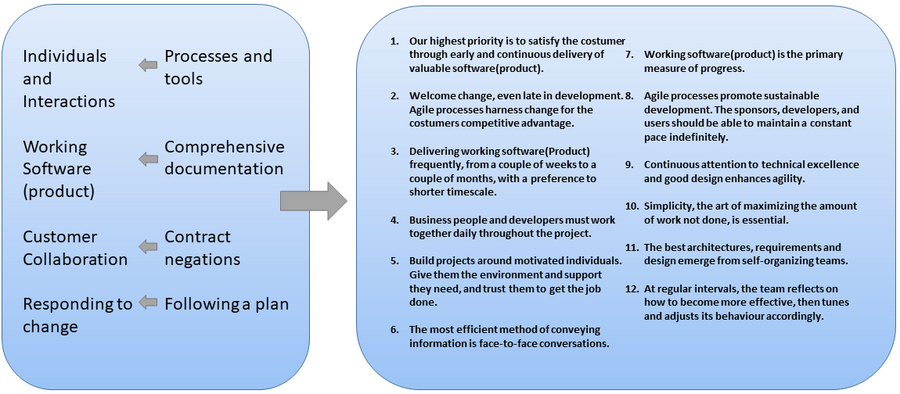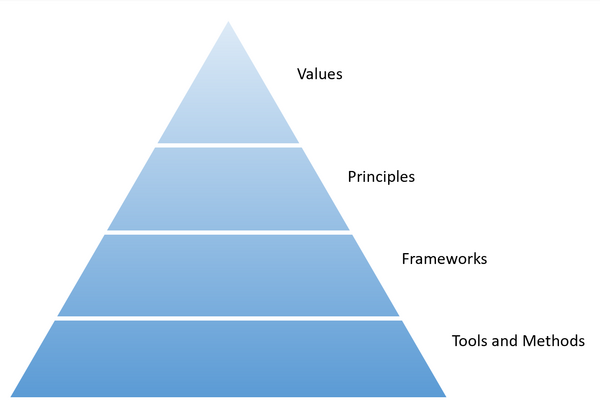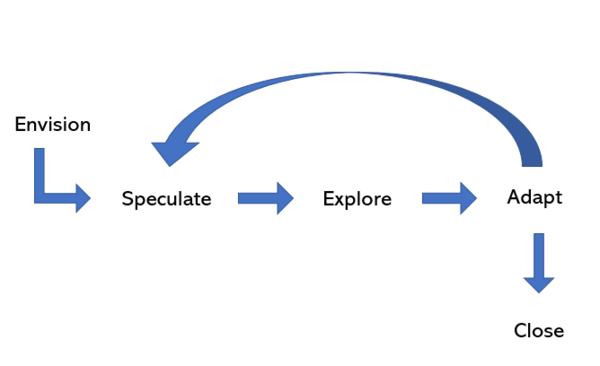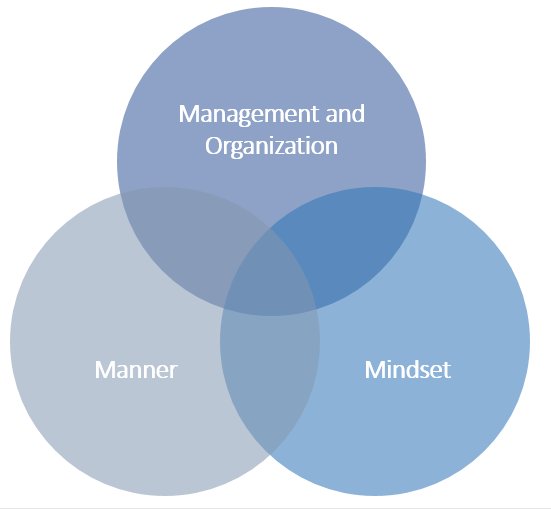Application of Agile
(→Principle no. 12 “At regular intervals, the team reflects on how to become more effective, then tunes and adjusts its behavior accordingly.”) |
(→Management and organization) |
||
| Line 62: | Line 62: | ||
=====Principle no. 12 “At regular intervals, the team reflects on how to become more effective, then tunes and adjusts its behavior accordingly.”===== | =====Principle no. 12 “At regular intervals, the team reflects on how to become more effective, then tunes and adjusts its behavior accordingly.”===== | ||
| − | A common way to secure learning is to evaluate team performance after a project, or if using the APM Framework after each sprint. Advantages of using APM Framework in this relation is that the evaluations is often and continually making it possible to apply the leanings i the rest of the project. | + | A common way to secure learning is to evaluate team performance after a project, or if using the APM Framework after each sprint. Advantages of using APM Framework in this relation is that the evaluations is often and continually making it possible to apply the leanings i the rest of the project<ref name="CIPp259-261"> ''Jim Highscmidth/Creating Innovative Products p.259-261'' </ref>. However, it is of cause also possible to evaluate on an ongoing basis without using APM Framwork, eg. a monthly team evaluation meeting. |
Revision as of 08:41, 27 February 2019
Abstract
This article decomposes Agile in order to make it clear what the prerequisites and gains from the use of Agile, and its different parts in a business. The Agile movement is all over and spreading widely and far from its origin in the software and IT sector, and its positive effects are reported extensively, there seems to be no stopping for agile. But originating from a software industry desiring to be more flexible, not every aspect of Agile is easy applicable in every business in various sectors eg. the construction sector has a whole different nature than the IT-development sector. Agile in its full form is covering various aspects as; way of structuring work, culture, management style etc. And while the use of iterative sprint increments can be opposed to the waterfall method, other parts as the management style is not opposed to the waterfall model. In this article Agile is decomposed into smaller parts by the use of the 12 principles of Agile. All of these parts of Agile is described in application, limits, gains and necessary setting for this to be applicable eg. limits due to the constraints of physicality. Lastly an overview model is presented highlighting the different aspects of Agile and their overlaps.This Article seeks to allow a business owners/consultants to analyze if Agile(or parts of Agile) is applicable to a business and rather throughout describe how to apply it.
Introduction
Agile is a way of doing project which has shown great results. Agile originates in the software industry, but has proven succesfull in other industries aswell. In the software development a success rate 28% bigger compared to projects based on a more classical project management approach[1].
Besides the success in Software Agile has spread far from this sector. Respondents to the yearly “State of Agile” report using Agile is from sectors as; Technology, Finans, Healthcare and onto Industrial/manufacturingwrite [2].
The advantages of Agile is reported to be extensive even in physical products. Some of the reported main advantages in physical product is “Increased transparency”, “increased internal learning”, “improved costumer understanding” but also onto very different parameters as “Shortened product development (Time-to-market)” and “Reduced risk for the product (eg. Technical feasibility, project failure)[3]. Note that these statements are from applying Agile to physical products.
Introducing Agile
In 2001 the present understanding of Agile originated with the Agile Manifest posted by 17 authors behind the Agile Alliance. The Manifest describes the fundamentals of Agile, in very broad formulations.[4] This version on Agile originated from the software industry that wanted more flexibility and felt limited by the classical way of managing projects.[5] Originating from these values are many ways of practicing agile. How to practically do Agile, will not be covered in this article, but it can serve as a great start to introduction to overall concept, the fundamentals needed in order to maintain overview when later choosing framework.
From the 4 values the 12 principles of Agile is created, outlining a bit more how to do Agile[5]. The principples cover the same, only the detail level and contretness differs, the main part of this article will take ins ofsrping in the 12 principles. KOMMENTER MERE PÅ FIGUREN
Further detailed than the principples is found in the Frameworkes used to practice Agile, famous ones to be mentioned could be; Scrum, Kanban, XP, ect. These all provid tools and practical ways of applying the principles of Agile. Some frameworks focus more on some parts of Agile some applying all and yet some only applying fewer. These Framework for different sectors and industries. The different frameworks of Agile might differ a lot from the values and principples on some points, though being somehow based on these. Agile is not just the these famouse frameworks but a whole umbrella of different ideas based on the same idea[5] . Nor is there a simple formula and easy steps, that will ensure succes[6]
There are many understandings of being Agile, practicing Agile or doing Agile. It is here noted that it is very possible to integrate some parts of Agile without the others. Also it is noted that one should be very carful then describing how practicing Agile or stating to be Agile, this can be interpreted on many ways by the receiver.
Introducing the Agile Project management Delivery Framework
In the implementation of several of the principles, the Agile Project Management Framework is often used[7], originalle proposed by Jim Highsmidt [8] This Framework as seen in FIGUR has an iterative nature, and Agile in general is often described as incremental as of this. This framework has 5 phases; Envision, speculate, explore, adapt and close. These corresponds to the 5 phases of the Waterfall method [9]; Initiating, planning, Executing, Controlling and Closing. The framework relies on the use of sprints that is smaller time intervals focusing on building a specific feature of the end product. Ideally each sprint should result in a part of the end product, the feature that can be delivered, tested and create value for the costumer [8] .Though this is often interpreteted as Agile, it is noted than this is only a framework to practice Agile. As of this, projects not using this framework might also be labeled Agile.
In the many comparison of the Agile project management framework to the Waterfall approach, Agile is equalized to be the APM Framework. However, as the following will reveal, this Framework is not a part of several of the Agile principles. As the use of “being Agile”, “Working Agile” “Doing Agile” etc. is free to use for anybody, it is not clearly defined how many of the values or principles that have to be fulfilled. A business utilizing all of the principles not needing the incremental iterative approach might label itself as Agile, though other businesses may not share that view.
Decomposing Agile into components
The 12 principles of Agile are outlining the four values from the manifest in more detail and taking the values closer to real life situations. Some are even quite practical and straight forward to understand in implementation. In the following the 12 principles of Agile will be analyized in terms of practicallity, wanted outcome and needed environment to run a project in line with each principle. When comparing to a specific business the reader will be able to see what parts of Agile is applicable to that. After having this overview and this knowledge the reader might proceed into finding a fitting framework covering the applicable parts of Agile for that specific business. In order to quicker analyze and provide more overview, these are analyzed in 3 different categories where they are found to have the biggest impact. These three categories is sole created for the purpose of this overview. The three categories is as follows; Management and organization, Mindset and Manner.
Management and organization
The following Principles are placed in the category of Management and organization, as they are found to have the biggest impart on that part of a business.
Principle no. 4 “Business people and developers must work together daily throughout the project”
The foundation of any project, is a business case[10]. To ensure, that the business case stays in line with developed product Agile suggests the responsible people working alongside. Though there might be different practical structures in different industries and businesses, this principle is applicable everywhere there is both developers and business people.
Principle no. 5 “Build projects around motivated individuals. Give them the environment and support they need, and trust them to get the job done”
Though this principle might be quite self-explanatory in its nature, the implementation can be quite difficult. The main thing needed to check of this principle, is motivated people. Agile believes in people over tools and process[11], therefore getting the right people is even more crucial[11]. According to Jim Highsmith, it should be prioritized over both product and process.MÅSKE NOGET MED AT ALLE IKKE KAN FÅ DE BEDSTE FOLK
Principle no. 11 “The best architectures, requirements and design emerge from self-organizing teams.”
Wanting the best requirements, architectures and design is an obvious want for every project leader but though self organizing-teams might sound relaxing for the manager, he or she has a significant role in making these work.[10]. The self-organized teams manages their own schedule, workload, effectiveness, however they are not to be precived as "self-directed" as the project manager still puts out the direction leading the team. Self organizing team Implies relying on and insisting on; Self-discipline, accountability and trust among other, which makes requirements to the behavior of the team members, which can also be fertilized by the project manager. This naturally requires both the employees, the right manager for this task is needed as well. If eg. a business employs people with a general lack of self-discipline or has very controlling project managers, this principle will be very hard to apply.
cases: Musk maybe
Principle no. 8 “Agile processes promote sustainable development. The sponsors, developers, and users should be able to maintain a constant pace indefinitely”
Using many of the Agile principles, can imply stress on the developers accountability from the self organizing teams, the many sprints used at the APM Framework. In this the role of the project manager is to watch out for stressed out employees[12]. Besides this, the process schould not be stressed i general so that any of the above listed cannot maintain pace.
Principle no. 12 “At regular intervals, the team reflects on how to become more effective, then tunes and adjusts its behavior accordingly.”
A common way to secure learning is to evaluate team performance after a project, or if using the APM Framework after each sprint. Advantages of using APM Framework in this relation is that the evaluations is often and continually making it possible to apply the leanings i the rest of the project[13]. However, it is of cause also possible to evaluate on an ongoing basis without using APM Framwork, eg. a monthly team evaluation meeting.
could be organized and under management, could be just in the culture and under Mindset. Wanted results:
ABOUT SOURCES: Therory: APM QC 50%
General
In general this part of Agile does not have many specific needs in terms of environment, if the management is dedicated to applying these principles.
Mindset – the mindset in the organization
Principle no. 9 “Continuous attention to technical excellence and good design enhances agility”
Practically: As with mindset Is all over in every doing Wanted results: Better quality and design Needed Environment: The right culture in the firm About Sources: Thery: SOMETHING ON CULTURE - Laura cases:
Principle no. 10 “Simplicity, the art of maximizing the amount of work not done, is essential”
Practically: As with mindset it is all over in every doing Wanted results: overall effectiveness Needed environment The right culture in the firm About Sources: Thery: SOMETHING ON CULTURE - Laura cases:
Principle no. 6 “The most efficient method of conveying information is face-to-face conversations”
Practically: Make sure people talk to each other face-face. Will require the right organizational set up ass well as culture. Wanted results: More effective communication. Needed environment: Same physical location. About sources: Theory: Not much needed.
Principle no. 2”Welcome change, even late in development. Agile processes harness change for the costumers competitive advantage”
Practically: In Agile working with “speculating” instead of “planning” means in practice to not try to plan more, than you are actually able to plan. Often also related to sprints. Wanted outcome: To not make useless plans which are not followed, and allow costumers to figure out their wants along the way, as costumers often does not realize their full wants from the very beginning. Environment needed In theory, no particular environment. But depending on the case/sector/industry there might be big differences in whether it is affordable. Also it will depend on which degree the costumer will be able to foresee his/hers needs. ABOUT SOURCES: Theory:
Manner – in which manner is the job done
Principle no. 1 “Our highest priority is to satisfy the costumer through early and continuous delivery of valuable software(product)”
Practically: This relates to the organization of the work in sprints, refer to sprints. Wanted results: Satisfying costumer by constant delivery and a constant check if the companies and costumers expectations are aligned. Needed environment: A WBS that allows continuously delivery of value. Eg. The foundation for a building is not much worth, without the building on top. WBS packages or sprint features that allows testing somehow. Constranits of physicality. Though this might be difficult to apply in the most direct form, it might be worth a consideration to still, as often recommended, have a strong costumer involvements.
Principle no. 3 “Delivering working software(Product) frequently, from a couple of weeks to a couple of months, with a preference to shorter timescale”
Practically: Short sprints/small WBS Wanted results: Same as previously just with the focus that it is constantly Needed environment Same as above, just with focus on small WBS packages or short sprint
Principle no. 7 “Working software(product) is the primary measure of progress”
Practically: Measuring by deliverables delived Wanted result: Keeping focus on delivering and not everything els, eg. Planning Needed environment: In theory; non. But makes the best sense if it is steadily growing in delivering software/product. Eg. Measuring deliver among of building or what ever does not give a fulfilling picture of the process.
Overview of the parts of Agile
More stuff goes here
References
- ↑ The Standish Group International, Inc./Choas report 2015 p. 7
- ↑ VersionOne/State Of Agile p. 6
- ↑ Schmidt, T. S., Weiss, S. and Paetzold, K. (2018) /Agile Development of Physical Products: An Emperical study about Motivations Potentials and Applicability p. 66
- ↑ https://www.agilealliance.org/
- ↑ 5.0 5.1 5.2 https://www.agilealliance.org/agile101/
- ↑ Jim Highsmith/Creating Innovative Products p.12-13
- ↑ ClydeBankBuisness/ Agile Project Management Quickstart guide, chapter 3
- ↑ 8.0 8.1 Jim Highsmith/Creating Innovative Products p.89
- ↑ ClydeBankBuisness/ Agile Project Management Quickstart guide, chapter 2
- ↑ 10.0 10.1 ALEXOS/PRINCE2 p.30
- ↑ 11.0 11.1 Jim Highscmidth/Creating Innovative Products p.52-53
- ↑ ClydeBankBuisness/Agile Project Management Quick Guide chapter 5
- ↑ Jim Highscmidth/Creating Innovative Products p.259-261



